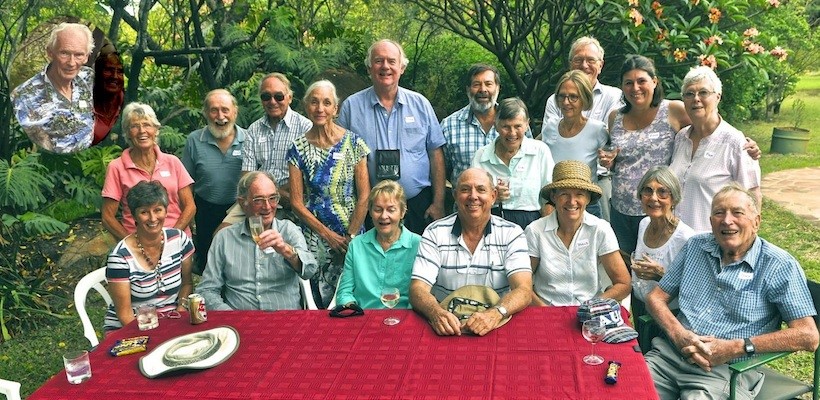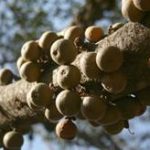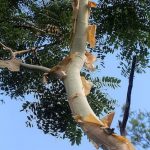TREE LIFE
JANUARY 2017
A VERY HAPPY 2017 to all our members.
MASHONALAND CALENDAR
Saturday January 7th: Botanic Garden Walk. Meet in the car park at 0845 for a 0900 start of the first Garden walk of the year, which will be completely different after the good rains. We’d like to try and find as many as possible of the trees that Gill Masterson listed in her 1981 Botanic Gardens walk (see December newsletter). See you there.
Sunday January 15th: Christon Bank. A return to this interesting area in the wet season when there should also be lovely ground orchids to see. We will meet at CABS Head Office parking area at 0900 for a 0915 start for those wanting to share transport. Alternatively meet at the Botanical Reserve Parking ground at 0945 hours. There will be a car guard – please bring a small donation for his services. Bring the usual, chair, hat, sun lotion, lunch and drinks and enjoy a day in this very lovely area.
OUTING TO STEVE AND KATRIN GAMBLE’s property, Highlands. We are going to meet at the Gamble’s home for an unmissable, enjoyable afternoon investigating and naming trees, as well as enjoying the lovely garden. Meet at 1415 for 1430.
A TRIBUTE TO DARREL PLOWES

Darrel Plowes. Photo: Flora of Zambia
Darrel passed away on 19th October 2016, aged 91. He was an outstanding naturalist whose inquiring mind and deep understanding of the natural world were an inspiration to me and others to take an interest in the flora and fauna around us. His knowledge was encyclopedic, even in frail old age. In fact when I mentioned we had seen excavated dinosaurs at Sentinel Ranch, he replied, “Oh, that’s Massospondylus whateveritwas”.
Few people knew he served in Italy from September 1944 in the S.A. Survey Corps attached to the American Fifth Army, often ahead of the main army and I only know this because I asked him, thinking he was well in the rear! He was born in Estcourt in 1925 and graduated with one of the first post war Agricultural Conservation degrees from Wits, from where he was appointed to the post of Pasture Research at Matopos Research Station and later to Nyamandhlovu Research Station as officer-in-charge. He was promoted to the post of Provincial Agricultural Officer in the Department of African Agriculture based in Mutare, which is where I first met him in 1960.
It was Darrel who gave me and my cousin David our first paid jobs. I was a student aged 20 in my third year reading Agriculture at the University of Natal. We applied to Mr Plowes for a vac. job. To our astonishment he trusted us with a brand new Land Rover pick up and together with camping gear and an African demonstrator, set off to map Maranke South for settlement. This area, in the ‘V’ between the Sabi and Odzi Rivers, was wild, full of animals and very difficult to cross except from Odzi, or crossing on foot at Hot Springs. Of course, it was totally unsuited to cropping, but we had to use aerial maps and stereoscopes to identify arable land, often only verified by slogging there on foot and once our guide got us completely lost for a day. We would have walked dozens of times over the Chiadzwa diamond field and not noticed the greasy little stones. If Darrel had been with us it might have changed our lives, because before Darrel joined the army, he worked as a prospector for the Consolidated Diamond Mines at Oranjemund!
Then I lost touch with Darrel for some 30 years, during which he continued working in agriculture until 1980, during which time he tirelessly trained small-scale farmers in sustainable land-use systems and raised conservation awareness, now sadly discarded from 1980 onwards. Before returning to Mutare, he worked extensively throughout Africa, including being resident in Botswana for 3 years, in Chad for 4 years and in Sudan for 4 years. During these long periods, his scientific curiosity added to his prodigious scientific knowledge.
Darrel was the principal author or co-authored 89 scientific articles in respected journals, discovered a new genus of grass Gazachloa in the Chimanimanis and has eight new species named after him, including a legless lizard, a mole rat, a butterfly, a species of Cape Bunting and in the botanical field: Aloe plowesii, a bulb Dierama plowesii and two succulent stapeliads Huernia plowesii and the Echidnopsis plowesianum.
He is probably best known by the layman for his book ‘Wild Flowers of Zimbabwe’, co-authored with Bob Drummond. His photo collection of 30 thousand slides is used as material in text books, travel guides and museums. His herbarium species are lodged at Kew, Pretoria and in our National Herbarium. His magnum opus on the Stapeliads was sadly just short of being completed and even a week before he died, he was anxious to get it done. Hopefully another scientist can complete it. His working hours were extraordinary, even in extreme old age, often working to 3 and 4 in the morning.
I recall my personal memories with Darrel with affection and I’m privileged that even with a 15 year age difference, I should be regarded as a friend. In the mid 90s Dr Colin Saunders, that great Lowveld doctor and conservationist, had started the Lowveld Natural History Society. When he moved to the Vumba, he encouraged me to start the Eastern Districts’ Natural History Society, of which Darrel and Anita were very keen supporters.
We had some memorable lectures at the Mutare Museum. Once Darrel showed his award winning film ‘Black Eagle Fly Free’, in which he recorded the successful nest building and rearing of the chicks on a precarious ledge at Murahwa’s Hill. On another occasion, he used his very professional flower slides to demonstrate the extraordinary beauty and diversity of the wild flowers of Nyanga and the Chimanis, while demonstrating the similarities and differences due to geology. The Chimanis are quartzite with some plants (e.g. Restios) closely allied to Cape flora, while Nyanga is granite and dolerite. Another memorable evening of slides by Darrel was of the wonders of Namaqualand in spring.
There were also good outings. Darrel’s knowledge of the pre-history of Zimbabwe gave us an insight into the Ziwa Ruins north of Nyanga, as well as on a subsequent visit to Harleigh Ruins and Diana’s Vow paintings near Rusape. One trip was made to Zhembe Mountain near Chimoio where Darrel, after a stiff climb to the saddle, pointed out the Mount Zembe endemics Huernia leachii (Stapeliad), Aloe decurva and Encephalartos munchii (Cycad).
There were two memorable, more recent trips with Darrel. One was to Gorongoza Game Reserve before it was re-habitated, where Darrel found an insignificant looking Stapeliad. We were also keen to see the Vanga Flycatcher. Lying on his stretcher, Darrel called out to me, “No need to get out of bed, they are in the tree overhead!” The other was a long trip to northern Mozambique with his grandson Simon and Tim Peatling, to Mount Namuli. It rained the whole way, with Darrel insisting on driving his own Land Rover, while I drove my own. The problem with travelling with an elderly botanist is that he didn’t get up too early and wanted to stop at each granite outcrop, when we had hundreds of kilometres to go. Our searches in the rain were fruitless, but on the return trip at a stop at an active granite quarry, Simon found the prized Huernia near Mocuba. A few years ago, Darryl wanted me to drive with him to Lubango in Angola but as he was in his late 80s, I reckoned it was a journey too far.
Important to me is the interest he had taken in the mountain grassland species on my property on the Zimbabwe/ Mozambique border, north of Penhalonga, which has already yielded Hesperantha petitiana – now lodged in the Kirstenbosch herbarium. Darrel has always been convinced that our Dierama, which is much smaller than the robust D. inyangense, is a new species. This will be clarified, with samples being sent to John Manning and Peter Goldblatt in Missouri.
Darrel was a naturalist who deserves recognition among the great collectors, such as Swynnerton and Chase, and those who revealed the amazing diversity of the Eastern Highlands.
-John Meikle
PLANTED TREES OF HARARE: Brazilian Peppertree, Schinus terebinthifolius
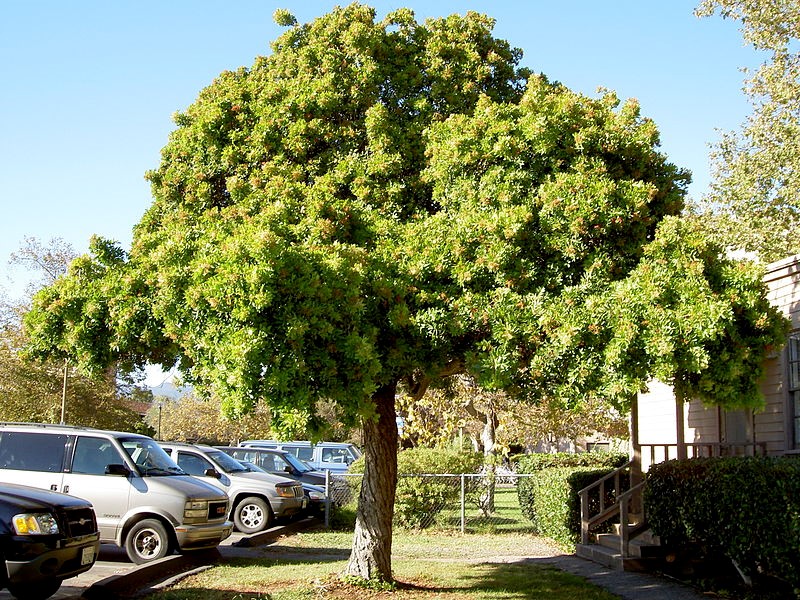
Schinus terebinthifolius
Schinus terebinthifolius belongs to the Mango family, Anacardiaceae, and is native to south-eastern Brazil, northern Argentina, and Paraguay. Common names include Brazilian Peppertree, Rose Pepper, Broadleaved Peppertree and Christmas Berry.
Within Harare, the Brazilian Peppertree is normally a small tree reaching a height of 4 – 8m. It is used as a street tree or in gardens as an ornamental tree. The branches can be upright, reclining or nearly vine-like, all on the same plant. This plastic morphology allows it to thrive in all kinds of ecosystems: from dunes to swamps, where it grows as a semi-aquatic plant. The leaves are alternate, 10–22 cm long, pinnately compound with 5–15 leaflets that sometimes have a winged rachis. The leaflets are roughly oval and have finely toothed margins, an acute to rounded apex and yellowish veins. The plant is dioecious with small white flowers borne profusely in axillary clusters. The fruit is a drupe 4–5 mm in diameter, carried in dense clusters.
Although it is not a true pepper, its dried drupes are often sold as pink peppercorns, as are the fruits from the related species Schinus molle (Peruvian Peppertree). The seeds can be used as a spice, adding a pepper-like taste to food. They are usually sold in the dry state and have a bright pink colour. The true pepper plants are mostly vines and belong to the family Piperaceae, which has over one thousand species.
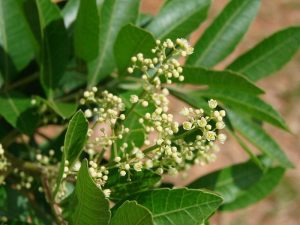
Schinus terebinthifolius flower
The Brazilian Peppertree has been planted in numerous countries and has become an invasive species in many sub-tropical regions with moderate to high rainfall. It is hard to control because it coppices if the trunk is cut. Trees also produce abundant seeds which are dispersed by birds and ants. This same hardiness makes the tree highly useful for reforestation in its native environment, but enables it to become invasive outside of its natural range.
Like many other species in the family Anacardiaceae, the Brazilian Peppertree has an aromatic sap that can cause skin reactions (similar to Poison Ivy burns) for some sensitive people. The burning of plant matter releases many airborne irritants, so it is not an effective means of control. It is said to have a “mace-like” effect upon nearby people so burning is not advised.
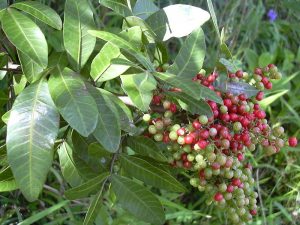
Schinus terebinthifolius fruit
Virtually all parts of this tropical tree have been used medicinally by indigenous peoples throughout the Tropics. The plant has a long history of use and appears in ancient religious artifacts and on idols among some of the ancient Chilean American Indians.
Throughout South and Central America, the Brazilian Peppertree is reported to be an astringent, antibacterial, diuretic, digestive stimulant, tonic, antiviral, wound healer etc. In South Africa, a leaf tea is used to treat colds, and a leaf decoction is inhaled for colds, hypertension, depression, and irregular heart beat.
-Tony Alegria – Source: Wikipedia
XMAS PARTY AT VAL D’OR, Sunday 4th December
OUTING TO IMIRE GAME PARK, WEDZA, Sunday 20th November
We arrived mid-morning at Imire’s Sable Lodge, situated under beautiful Brachystegia spiciformis and green lawns, and were greeted with tea, coffee and eats. The habitat is sandveld miombo woodland. Mary divided the large party, 27 members, into the Green group led by Tony and the Red group led by Tom.
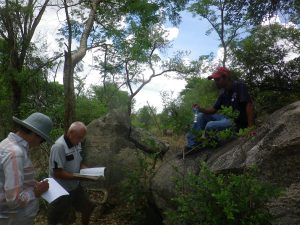
Imire outing
We boarded the large safari vehicle, entered the Game Park and made for a large granite feature called Castle Rock where we parked in the shade of Acacia galpinii in a bush camp. Tom explained there are over fourty African species of Acacia, with prickles or spines, bipinnate leaves, leaflets small and commonly numerous. For example A. galpinii leaves: up to 14 pairs of pinnae, each bearing up to 40 pairs of leaflets. We saw four Acacias: karroo, rehmanniana, sieberiana and galpinii. If an Acacia has curved spines, it is likely to have spiked, straight inflorescences. Straight spines will likely have round flowers.
We disembarked and the two groups went separate ways, following a water-way. We saw:
Carissa edulis, Apocynaceae family, commonly known as Num-num, but it was not fruiting.
Peltophorum africanum, family Caesalpinioideae, African Wattle. The bipinnate leaves are a dull green above and paler below and have showy, dense sprays of yellow flowers.
Euclea divinorum, family Ebenaceae, Magic Guarri. It has dark green leaves with wavy edges. The wood is thought to have supernatural powers and the leaves do not appear to be browsed even in the game park. Other Eucleas we saw were E. linearis, another small tree with linear, sickle shaped leaves, that produces purple/black edible fruit. Also E. schimperi, usually on termite mounds with leaves similar to divinorum but the leaves are wider above the middle.
Also in the Ebenaceae family, was Diospyros lycioides, Star apple, with last season’s dried fruit still on the tree. Dull grey-green leaves are crowded at the tips of the branches, this was a common shrub-like tree all over the park.
A treat, typically making a showing after first rain, was Scadoxus multiflorus, the red many-flowered umbel glowing from under the vegetation, often near rocky outcrops. The flower stem is spotted with purple and the leaves glossy green.
Combretum erythrophyllum, River Combretum, we saw on the stream bank, typically many stemmed from the base. Later, away from the stream, we saw Combretum zeyheri, the Large-fruit Combretum, with last season’s four-winged fruit on the ground. There was also Combretum molle, with its broadly ovate almost circular leaves with grey velvet hairs making it conspicuous.
Then we saw a fig, family Moraceae, with roots sprawling all over a rocky outcrop and into crevices. It had smooth, pale bark, possibly F. glumosa, Mountain Rock Fig, which was difficult to identify as there were no leaves and new fruit could be seen clustered at the ends of the branches. Right on the water’s edge was Ficus sur, smooth pale bark with the fruit clusters on the trunk and the emergent leaves a conspicuous red.
Dovyalis zeyheri, family Flacourtiaceae, was also present among the rocks. This is a small tree armed with spines and leaves clustered on branchlets, flowers greenish-yellow with a mass of stamens in the centre. Also in this family was Flacourtia indica, Governors Plum, a small tree typical of open woodland, the bark, pale grey and flaking to show orange patches. Off the main trunk were long spines. We saw no flowers but in autumn the leaves can become red to purple.
Next we came across:
Gymnosporia senegalensis (ex. Maytenus senegalensis) Confetti Spikethorn, family Celastraceae. The leaves are spirally arranged or fascicled on the spines, being leathery and pale blue-green. Flowers were cream to greenish, not in profusion to look confetti-like.
Olea europaea (Olea africana) Family Oleaceae, African Olive. Bilal spotted a minute-leaved specimen close to the ground, looking like a bonsai from overgrazing. We did later find a more typical looking small tree with drooping linear grey-green leaves. These drought resistant plants have been used as the rootstock onto which the commercial olive stock is grafted.
We boarded our safari truck and moved to the more open woodland and saw many Sable antelope with young, as well as Kudu. Two female Black Rhino and a three year old calf dutifully came up close to be treated to some cubes. Zebra, Waterbuck, Impala and Warthogs with very young in tow were also seen.
We again disembarked to take a walk in the woodland and came across:
Ozoroa reticulata, Tarberry, family Anacardiaceae. The bark is brown, flaking into small squares, with rather hairy branchlets. The leaves are spirally arranged in whorls of three, elliptic, long and slender and densely covered in hairs. The net veins are conspicuous, as the name ‘reticulata’ suggests.
Dichrostachys cinerea, Sickle Bush, Family Mimosoideae. This could be mistaken for an Acacia with its spines and bipinnate leaves clustered on branchlets, with up to 19 pinnae and 27 pairs of leaflets, and a raised gland between the pairs of pinnae. The pink spiked flowers held in a yellow catkin are striking. The pod is a twisted cluster, rather attractive and distinctive.
Parinari curatellifolia, Mobola-plum, Family Chrysobalanaceae. These beautiful, large, densely crowned trees were almost in groves. Their leaves are simple, leathery and velvety. The many parallel veins are close together, the leaf margin can look wavy and glands can be seen on the petiole. The fruit, 5 x 3.5cm, is fleshy and edible and as a result the tree is seldom cut down. Also silica crystals in the wood will blunt any tool. This is David Livingstone’s tree. After his death in 1873 an inscription was carved on the trunk of a P. curatellifolia in Zambia.
Albizia antunesiana, Purple-leaved Albizia, Family Mimosoideae. Leaves with a rachis 13 cm long, up to three pairs of pinnae with about 5 pairs of large, opposite leaflets, with a distinct asymmetric base. The flowers are the typical Albizia ‘shaving brush’. Young trees can look purple-leaved. At a glance this tree can be mistaken for Burkea africana, Family Caesalpinioideae, which was growing in close proximity, but the leaves are bipinnate, 3 pairs of pinnae with up to 9 alternate leaflets and a brown velvet growing tip to the branchlets is a characteristic.
Ochna schweinfurthiana, Family Ochnaceae, Brick-red Ochna. This was a small tree, the bark cracked into squares, leaves elliptic, about 10 cm long with many closely spaced lateral veins. No flowers were present and the fruit was not in the conspicuous orange to brick-red stage.
Terminalia sericea, Silver Terminalia, Family Combretaceae, another common tree of the woodland. The bark is brownish to grey and longitudinally fissured and the twigs peeling. The silver leaves are clustered at the tips of small branches as with most terminalia.
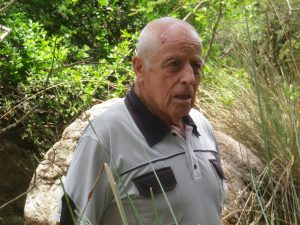
The inimitable Dr Tom Muller
Strychnos spinosa, Spiny Monkey-orange, Family Strychnaceae. This was a small tree, which had grey and flaking bark, with small paler branches and slightly curved spines. The leaves were in pairs, rounded, glossy and obviously 3 veined almost from the base. The fruit can be 12 cm in diameter, green becoming yellow and there can be up to 100 seeds in the edible pulp.
Towards the end of the walk an impressive large tree some distance away in bright new green leaves drew our attention. Tom made us guess what it was as we approached. Getting closer, the large, round green pods of Pterocarpus angolensis, Mukwa or Bloodwood, Family Papilionoideae, became visible. The usually grey brown and fissured bark was not obvious here, as over time fire had blackened the trunk. The distinctive fruit pod with its wavy wing about 3cm wide surrounding the bristly seed case is conspicuous in winter when the tree is leafless. Tom said that this impressive specimen must be growing on deep sands.
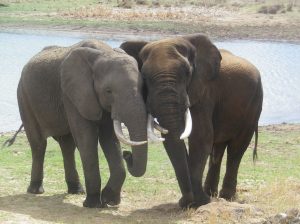
Elephants at Imire
On the way back to the Safari truck Lannea edulis, Family Anacardiaceae, was spotted as the fruit, a scarlet globose drupe, drew our attention. These are often overlooked, as this shrublet with strong underground roots and stem (a geoxyle) appears annually. It has 2-4 pairs of leaflets and a terminal one, the leaflets being ovate and opposite. The cream flowers are small and the edible fruit become purple/black when ripe.
We drove to the dam where we were served drinks and a delicious lunch and watched the elephants frolicking in the water and eating game cubes. Then back to Sable Lodge for tea and coffee and biscuits and we prepared to depart to avoid the setting sun on the way back to Harare.
Many thanks to Mary for her planning and the Travers family for their hospitality at their most attractive lodge.
Anne Butler
TONY ALEGRIA – CHAIRMAN


